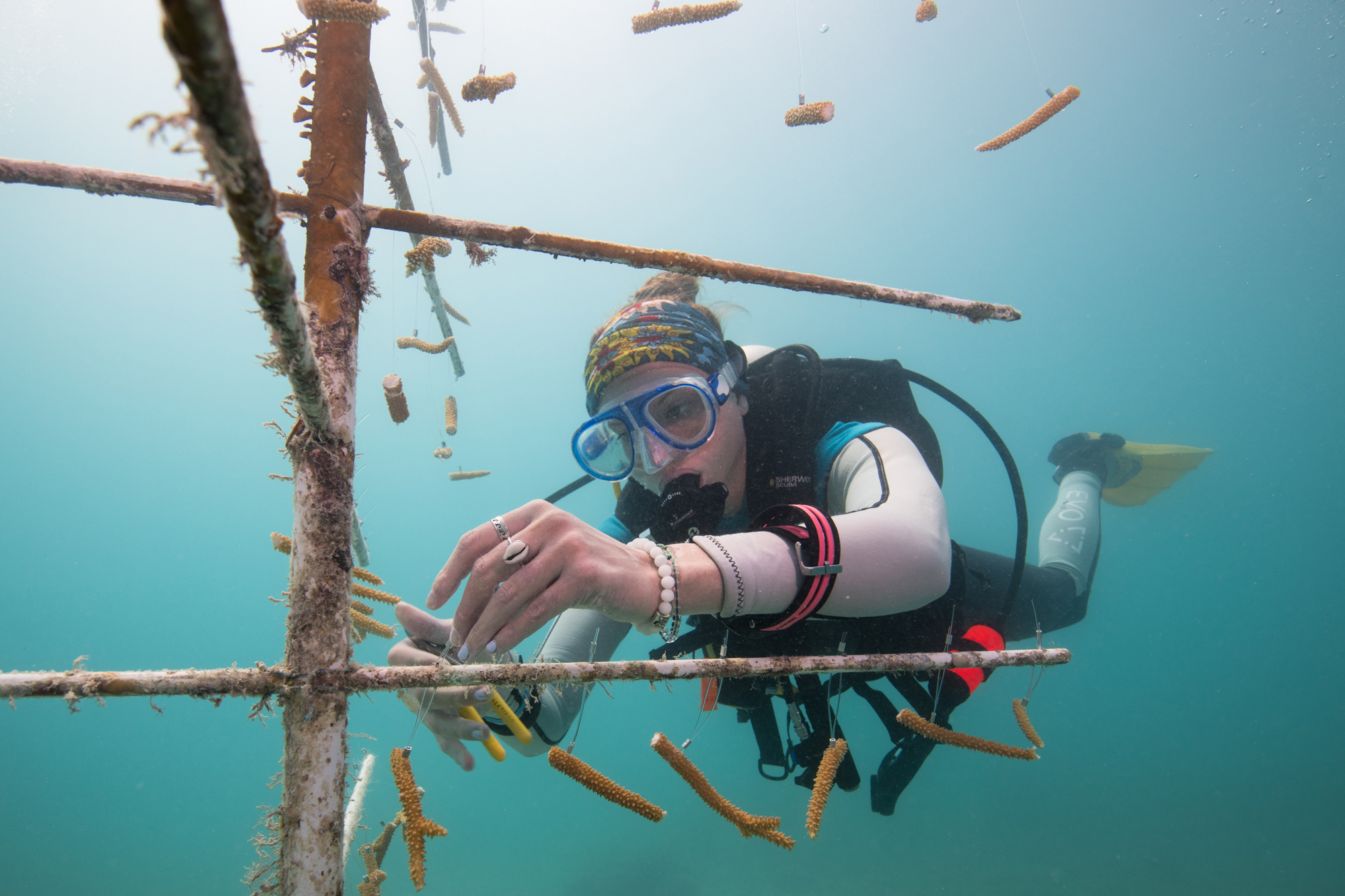Jennifer Adler
Jennifer Adler
Jennifer Adler
United States
United States
United States
About series
About series
About series
This body of work draws from stories that feature female scientists and the aquatic ecosystems they study—from freshwater in Florida to coral reefs in Mexico and remote Tahitian atolls.
—Although storytelling often has a negative connotation among data-driven scientists, communication is an essential element of science. Visual stories can humanize scientists and give a behind-the-scenes glimpse into their lives that makes them more relatable, trustworthy, and understandable.
—We especially need more stories about women in science because male scientists dominate news stories, keynotes, invited panels, and upper-level faculty positions. Stories that focus on female scientists can inspire the next generation and help people connect with research that is often buried deep in the pages of peer-reviewed academic journals—or beneath the water’s surface.
Eruption
Eruption
Eruption
Air clear spring water takes on an orange hue as a fluorescent water tracing dye (“Rhodamine WT”) swirls throughout Silver Spring in Florida. Dr. Erin White, a hydrogeologist, snorkels in the center of the swirl of Rhodamine WT. She and about a half dozen other graduate students, scientific divers, volunteers, and fellow lab-mates in Dr. David Kaplan’s Watershed Ecology Lab at the University of Florida joined forces to perform a series of these studies at freshwater springs throughout Florida. After the dye is released, they measure its concentration downstream with devices called fluorometers. This work helps them understand how the water moves and mixes and calculate the amount of time it spends in the river channel as it flows downstream from the headspring.
Air clear spring water takes on an orange hue as a fluorescent water tracing dye (“Rhodamine WT”) swirls throughout Silver Spring in Florida. Dr. Erin White, a hydrogeologist, snorkels in the center of the swirl of Rhodamine WT. She and about a half dozen other graduate students, scientific divers, volunteers, and fellow lab-mates in Dr. David Kaplan’s Watershed Ecology Lab at the University of Florida joined forces to perform a series of these studies at freshwater springs throughout Florida. After the dye is released, they measure its concentration downstream with devices called fluorometers. This work helps them understand how the water moves and mixes and calculate the amount of time it spends in the river channel as it flows downstream from the headspring.
Air clear spring water takes on an orange hue as a fluorescent water tracing dye (“Rhodamine WT”) swirls throughout Silver Spring in Florida. Dr. Erin White, a hydrogeologist, snorkels in the center of the swirl of Rhodamine WT. She and about a half dozen other graduate students, scientific divers, volunteers, and fellow lab-mates in Dr. David Kaplan’s Watershed Ecology Lab at the University of Florida joined forces to perform a series of these studies at freshwater springs throughout Florida. After the dye is released, they measure its concentration downstream with devices called fluorometers. This work helps them understand how the water moves and mixes and calculate the amount of time it spends in the river channel as it flows downstream from the headspring.

Snapper
Snapper
Snapper
Megan De Angelis holds a snapping turtle (Chelydra serpentina) she caught during a mark-recapture study at Hornsby Spring, a spring along the Santa Fe River in north Florida. While most swimmers do not encounter snapping turtles, they are usually nearby, hiding in the dark shadows or tucked away just out of sight. De Angelis is a biology student who volunteers with the Santa Fe Turtle research group, which has monitored turtle populations in this area since 2004. There are 14 native species of freshwater turtles in the Santa Fe River basin—almost the same number as the entire Amazon River system, which is more than 2,000 times its size. This small river basin nestled in quiet north Florida is a globally significant turtle diversity hotspot.
Megan De Angelis holds a snapping turtle (Chelydra serpentina) she caught during a mark-recapture study at Hornsby Spring, a spring along the Santa Fe River in north Florida. While most swimmers do not encounter snapping turtles, they are usually nearby, hiding in the dark shadows or tucked away just out of sight. De Angelis is a biology student who volunteers with the Santa Fe Turtle research group, which has monitored turtle populations in this area since 2004. There are 14 native species of freshwater turtles in the Santa Fe River basin—almost the same number as the entire Amazon River system, which is more than 2,000 times its size. This small river basin nestled in quiet north Florida is a globally significant turtle diversity hotspot.
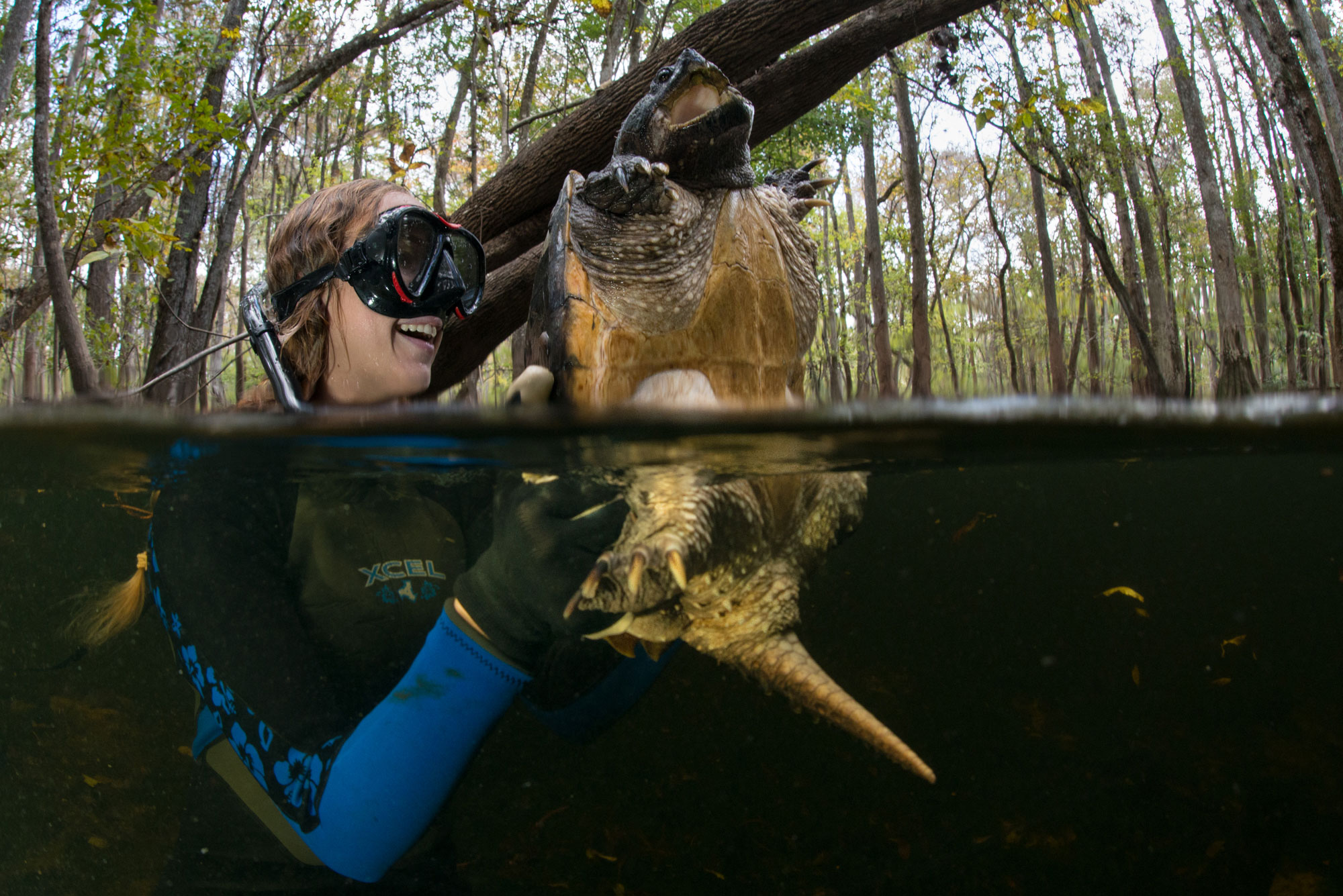
Warrior
Warrior
Warrior
Dr. Jordan Casey spearfishes for science. Spear gun in hand, she freedives for hours in the waters surrounding Tetiaroa, a remote Tahitian atoll. She and her group target certain species of fish that they will later dissect in the lab. Peering into their stomachs to see what they eat helps Casey and her collaborators better understand the complex marine food web.
Dr. Jordan Casey spearfishes for science. Spear gun in hand, she freedives for hours in the waters surrounding Tetiaroa, a remote Tahitian atoll. She and her group target certain species of fish that they will later dissect in the lab. Peering into their stomachs to see what they eat helps Casey and her collaborators better understand the complex marine food web.

Repair
Repair
Repair
Ana Cobarrubias uses a hydraulic drill during a training course on the Mesoamerican reef off Puerto Morelos, Mexico. In summer 2018, The Nature Conservancy, Mexico’s National Park Service, and local reef researchers trained local people to be ‘Guardians of the Reef.’ This four-day course on rapid reef repair brought together fishermen, hotel owners, tour operators, government representatives, developers, coral specialists and university researchers to seek a solution to restore Quintana Roo’s coral reefs.
Ana Cobarrubias uses a hydraulic drill during a training course on the Mesoamerican reef off Puerto Morelos, Mexico. In summer 2018, The Nature Conservancy, Mexico’s National Park Service, and local reef researchers trained local people to be ‘Guardians of the Reef.’ This four-day course on rapid reef repair brought together fishermen, hotel owners, tour operators, government representatives, developers, coral specialists and university researchers to seek a solution to restore Quintana Roo’s coral reefs.
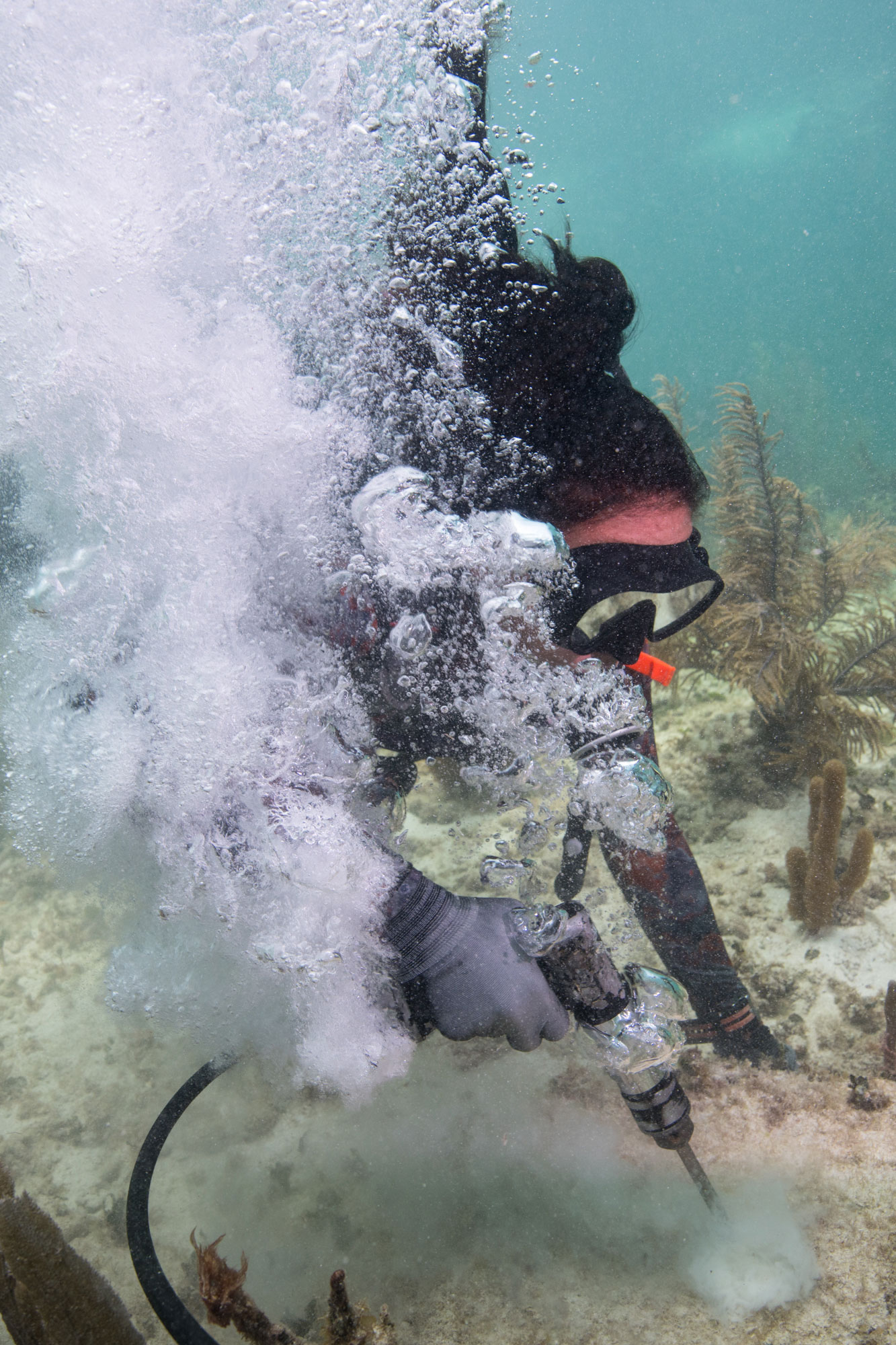
Barrier
Barrier
Barrier
The Mesoamerican reef is the longest barrier reef in the Western Hemisphere, stretching about 1,000 km from the northern tip of the Yucatán down to Belize, Guatemala, and Honduras. There are 47 marine protected areas along the reef, including this one just south of Cancun in Puerto Morelos, Mexico. Healthy coral reefs can reduce up to 97% of wave energy coming to shore, which makes them especially important natural barriers during hurricanes. During a four day training course, The Nature Conservancy, Mexico’s National Park service, and reef researchers trained local people to be ‘Guardians of the Reef.’ After a hurricane, they repair the damaged reef so that it can continue to provide protection and support their livelihoods that are so inextricably tied to the sea.
The Mesoamerican reef is the longest barrier reef in the Western Hemisphere, stretching about 1,000 km from the northern tip of the Yucatán down to Belize, Guatemala, and Honduras. There are 47 marine protected areas along the reef, including this one just south of Cancun in Puerto Morelos, Mexico. Healthy coral reefs can reduce up to 97% of wave energy coming to shore, which makes them especially important natural barriers during hurricanes. During a four day training course, The Nature Conservancy, Mexico’s National Park service, and reef researchers trained local people to be ‘Guardians of the Reef.’ After a hurricane, they repair the damaged reef so that it can continue to provide protection and support their livelihoods that are so inextricably tied to the sea.

Capture
Capture
Capture
Megan De Angelis captures a Suwannee cooter (Pseudemys suwanniensis) in Hornsby Spring as part of a long-term turtle study in Florida’s Santa Fe River basin. The state-protected Suwannee cooter provides an avenue through which to tell the story of Florida’s springs. Since the 1990s, the springs have transitioned to an algal-dominated state: once full of lush underwater meadows of native grasses, many are now carpeted with algae. These turtles are vegetarians—and their once-well-stocked underwater salad bar is disappearing. Via this project, researchers have found that turtles are traveling farther and farther to find food—they recently documented the farthest movement by a North American freshwater turtle and found that since vegetation began to disappear in the Santa Fe River in 2012, turtles in this system have been regularly swimming upwards of 40 km to find food.
Megan De Angelis captures a Suwannee cooter (Pseudemys suwanniensis) in Hornsby Spring as part of a long-term turtle study in Florida’s Santa Fe River basin. The state-protected Suwannee cooter provides an avenue through which to tell the story of Florida’s springs. Since the 1990s, the springs have transitioned to an algal-dominated state: once full of lush underwater meadows of native grasses, many are now carpeted with algae. These turtles are vegetarians—and their once-well-stocked underwater salad bar is disappearing. Via this project, researchers have found that turtles are traveling farther and farther to find food—they recently documented the farthest movement by a North American freshwater turtle and found that since vegetation began to disappear in the Santa Fe River in 2012, turtles in this system have been regularly swimming upwards of 40 km to find food.
Crypto
Crypto
Crypto
Drs. Jordan Casey and Simon Brandl swim a net overhead as they prepare to drape it over a coral head in the waters surrounding Tetiaroa in French Polynesia. They are targeting small, bottom-dwelling (‘cryptobenthic’) fishes, which account for about half of all reef fish species and individuals. Due to their small size and cryptic lifestyle, scientists are only beginning to explore the diversity, distribution, ecology, and evolution of this “hidden half” of coral reef fishes. In French Polynesia, Casey, Brandl, and their colleagues are trying to understand how human disturbances (especially fishing and climate change) may affect coral reef food webs and impact even the smallest marine fishes.
Drs. Jordan Casey and Simon Brandl swim a net overhead as they prepare to drape it over a coral head in the waters surrounding Tetiaroa in French Polynesia. They are targeting small, bottom-dwelling (‘cryptobenthic’) fishes, which account for about half of all reef fish species and individuals. Due to their small size and cryptic lifestyle, scientists are only beginning to explore the diversity, distribution, ecology, and evolution of this “hidden half” of coral reef fishes. In French Polynesia, Casey, Brandl, and their colleagues are trying to understand how human disturbances (especially fishing and climate change) may affect coral reef food webs and impact even the smallest marine fishes.
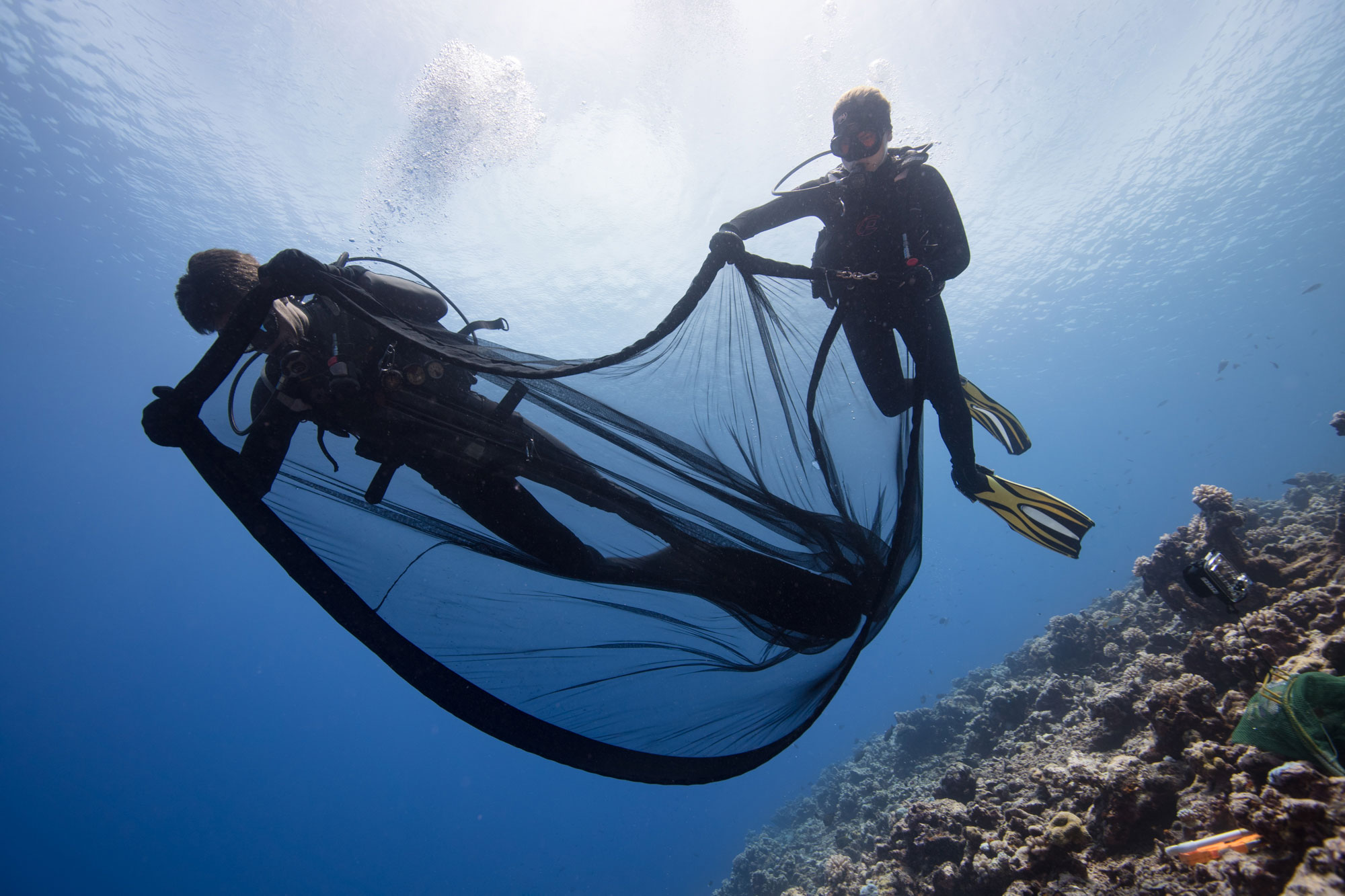
Elkhorn
Elkhorn
Elkhorn
Some of the last remaining healthy stands of elkhorn coral (Acropora palmata) populations are found in the waters of Parque Nacional Arrecife de Puerto Morelos in Mexico. These corals are reminiscent of the redwoods of the sea, towering over the bottom with elaborate, branching arms. This once-dominant reef-building coral has suffered drastic declines in the Caribbean, beginning in the 1970s, and large stands are now relatively rare. The decline of elkhorn coral in this region has largely been due to white-band disease followed by severe hurricanes that broke down coral tissue; white-pox disease, increasing ocean temperatures, and pollution worsened mortality.
Some of the last remaining healthy stands of elkhorn coral (Acropora palmata) populations are found in the waters of Parque Nacional Arrecife de Puerto Morelos in Mexico. These corals are reminiscent of the redwoods of the sea, towering over the bottom with elaborate, branching arms. This once-dominant reef-building coral has suffered drastic declines in the Caribbean, beginning in the 1970s, and large stands are now relatively rare. The decline of elkhorn coral in this region has largely been due to white-band disease followed by severe hurricanes that broke down coral tissue; white-pox disease, increasing ocean temperatures, and pollution worsened mortality.
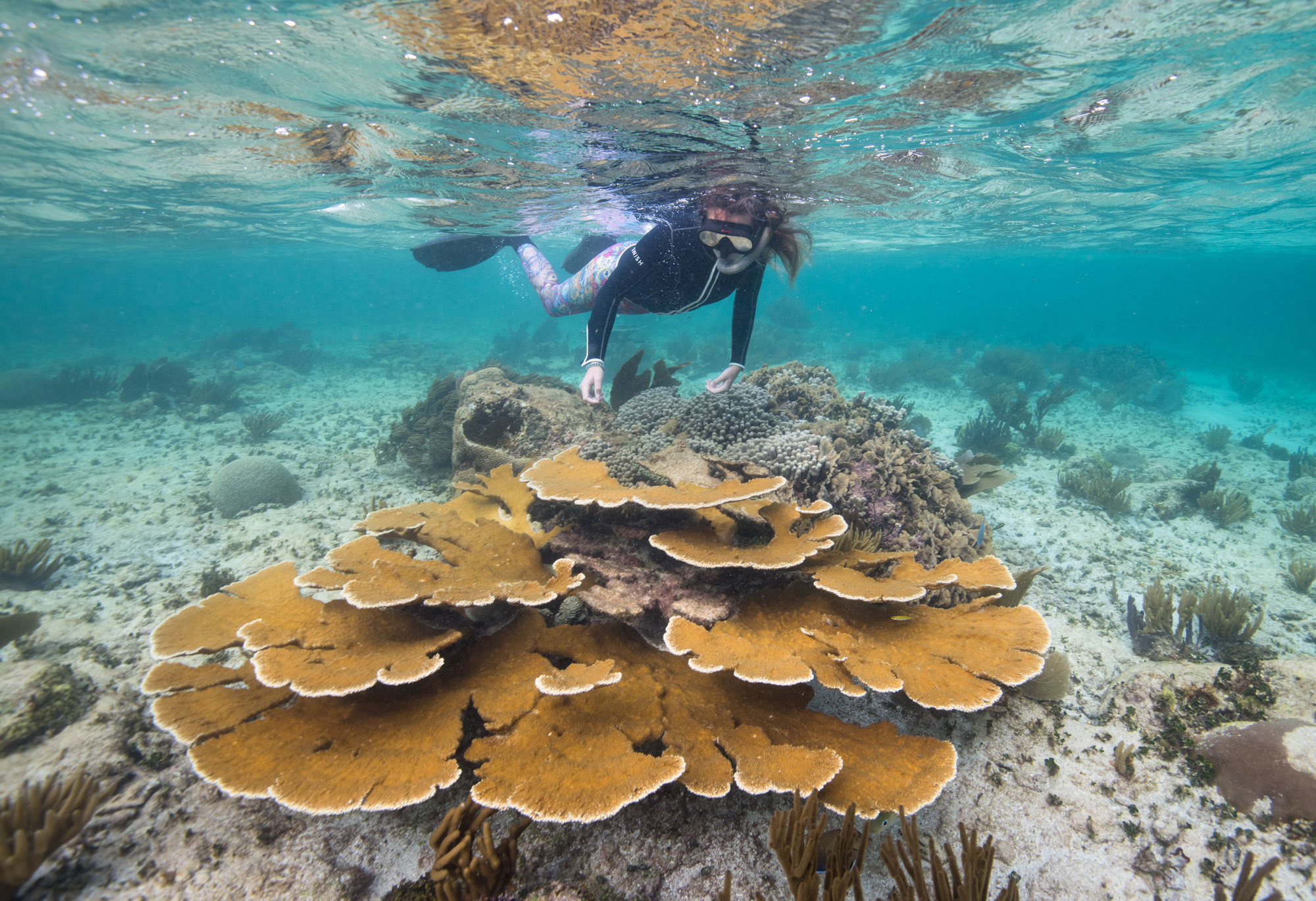
Forest
Forest
Forest
Rebecah Delp hangs pieces of staghorn coral (Acropora cervicornis) on a coral tree in Dry Tortugas National Park. The corals hang like ornaments on a Christmas tree, but unlike their coniferous counterparts, these underwater trees stay decorated for a year as the corals grow. After a year, scientists return and cut the corals from the trees to plant on nearby reefs. Delp and 7 other scientists planted 1,220 fragments of staghorn coral in the Dry Tortugas during a week-long trip in June 2018.
Rebecah Delp hangs pieces of staghorn coral (Acropora cervicornis) on a coral tree in Dry Tortugas National Park. The corals hang like ornaments on a Christmas tree, but unlike their coniferous counterparts, these underwater trees stay decorated for a year as the corals grow. After a year, scientists return and cut the corals from the trees to plant on nearby reefs. Delp and 7 other scientists planted 1,220 fragments of staghorn coral in the Dry Tortugas during a week-long trip in June 2018.
Rebecah Delp hangs pieces of staghorn coral (Acropora cervicornis) on a coral tree in Dry Tortugas National Park. The corals hang like ornaments on a Christmas tree, but unlike their coniferous counterparts, these underwater trees stay decorated for a year as the corals grow. After a year, scientists return and cut the corals from the trees to plant on nearby reefs. Delp and 7 other scientists planted 1,220 fragments of staghorn coral in the Dry Tortugas during a week-long trip in June 2018.
